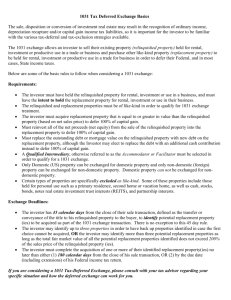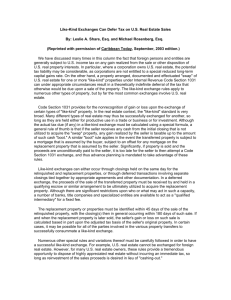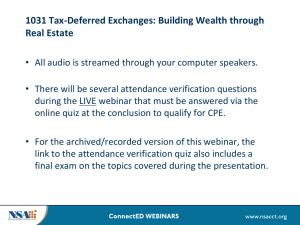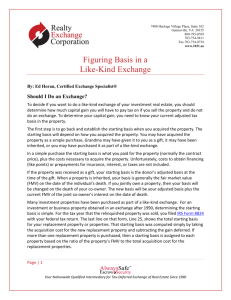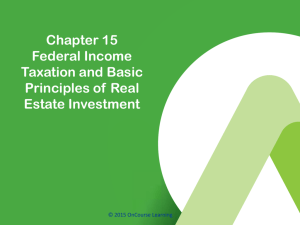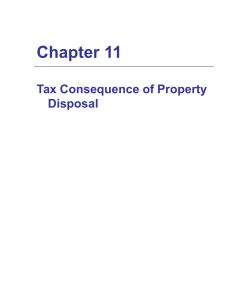1031 Tax-Deferred Exchanges
advertisement
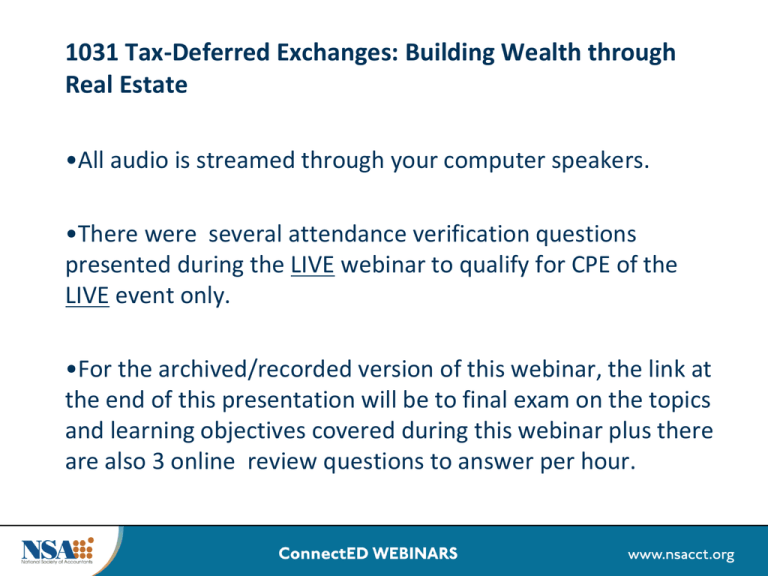
1031 Tax-Deferred Exchanges: Building Wealth through Real Estate •All audio is streamed through your computer speakers. •There were several attendance verification questions presented during the LIVE webinar to qualify for CPE of the LIVE event only. •For the archived/recorded version of this webinar, the link at the end of this presentation will be to final exam on the topics and learning objectives covered during this webinar plus there are also 3 online review questions to answer per hour. §1031 Tax-Deferred Exchanges: Building Wealth through Real Estate Qualifications for a “Like-Kind” Exchange 2 Learning Objectives Upon completion of this webinar you will be able to: • Define the "Like-Kind" exchange & requirements for tax-deferred exchange. • List the steps involved in properly executing a Sec 1031 tax-deferred "likekind" exchange. • Identify types of real estate properties such as principal residence, investment properties, vacation homes, and which qualify for a tax-deferred exchange. • Define the rules for identifying replacement property. • Identify special circumstances of exchanges. • Identify who can serve as a qualified intermediary. • Determine what is a related party exchange and who is a related party. • Identify problems with related party exchanges. • Determine qualifications of vacation home properties. • Recognize disaster area extensions. 3 §1031 Tax-Deferred Exchanges Tax-deferred exchange allows you to preserve your wealth through reinvestment in “like-kind” assets. A tax-deferred exchange allows for deferral of capital gains taxes if structured correctly. 4 The Concept of “Like-Kind” Any real or personal property can be exchanged, provided it is held for “Productive use in a trade or business” or For investment, and Is exchanged for “like-kind” property that will be held for the same purpose 5 What is “Like-Kind”? Like-kind does not mean exactly the same Single family rental unit may be exchanged for other real property such as Warehouse, retail center, office building, farm property, leasehold interest in real estate 6 What is “Like-Kind”? Most real property is “like-kind” to other real property. Real property is not “like-kind” to personal property. 7 “Like-Kind” Exchange Example You acquired an improved property for $800,000 four years ago. Current mortgage balance is $600,000 Property has appreciated to $1,800,000 Depreciation deductions of $100,000 $175,000 Capital Gains taxes if sold No Capital Gains taxes if deferred-exchange 8 “Like-Kind” Exchange Example SALE EXCHANGE Current Value $1,800,000 $1,800,000 Mortgage Payoff $(600,000) $(600,000) Tax on $1,000,000 Appreciation @ 15% $(150,000) Deferred Tax on $100,000 Depreciation Recapture @ 25% $(25,000) Deferred Available for Reinvestment $1,025,000 $1,200,000 Value of Replacement Property 30% Down $3,416,667 $4,000,000 9 Requirements for Tax-Deferred Exchange Identification period Exchange period Fully deferred exchanges 10 Identification Period Replacement property must be identified within 45 days of the transfer of the relinquished property. Deadline can not be extended for weekends or holidays. 11 Exchange Period Acquisition of replacement property must be completed by the earlier of 180 days of the transfer of the relinquished property, or The due date of filing your federal tax return for the year in which property was relinquished (includes extensions). 12 Fully Deferred Exchanges Exchange will be fully tax-deferred only if Replacement property is equal to or greater in value and equity than your relinquished property Debt of your replacement property must also be equal to or greater than debt on relinquished property unless cash is added to offset debt 13 Rules for Identifying Replacement Property 3-Property Rule (Three properties regardless of value), or 200 Percent Rule (Any number of properties, as long as combined FMV doesn’t exceed twice the value of relinquished property), or 95 Percent Rule (Any number of properties, regardless of combined FMV, as long as you acquire 95% or more of the total value of properties) 14 1031 Exchange Process Use a “Qualified Intermediary” to ensure a successful and smooth transaction Use a reputable and knowledgeable realtor Use a “real estate” attorney experienced with 1031 exchanges Allow sufficient time to complete entire real estate transaction 15 1031 Exchange Process - Step 1 Purchase Contract –Relinquished Property The contract between you and your buyer should contain a “cooperation clause” Cooperation clause should state that buyer agrees to an assignment of the contract by the seller to the QI 16 1031 Exchange Process – Step 2 Exchange Documentation Contact the Qualified Intermediary (QI) to start tax-deferred exchange process QI will prepare exchange agreement, Assignment of the relinquished property purchase contract, Notice of the assignment, and Instructions to the settlement agent 17 1031 Exchange Process – Step 3 Closing the relinquished property Property will be conveyed to buyer Cash proceeds from sale must be delivered to the QI. You should never be in either actual or constructive receipt of the cash proceeds 18 1031 Exchange Process – Step 4 Investment of cash proceeds & identification forms After closing of relinquished property the QI will hold the proceeds, and Provide you with forms to identify replacement properties within the 45 day identification period 19 1031 Exchange Process – Step 5 Purchase Contract–Replacement Property Enter into purchase contract with seller Replacement property purchase contract should have “cooperation clause” 20 1031 Exchange Process – Step 6 Exchange Documentation Qualified Intermediary will prepare Assignment of the replacement property purchase contract (assign rights to QI) Notice of the assignment (deliver to seller) Instructions to the settlement agent 21 1031 Exchange Process – Step 7 Closing the Replacement Property Qualified Intermediary delivers exchange proceeds to purchase replacement property Seller will convey replacement property Closing must occur by 180 days from date of closing of relinquished property, or due date of filing federal tax return 22 1031 Exchange Process – Step 8 Completion of Your Exchange Qualified Intermediary provides you all the exchange documents including proof of Receipt and disbursement of all exchange funds Complete Form 8824 to file with tax return 23 Why Do I Need a Qualified Intermediary? A QI is necessary to create the exchange correctly It requires experience, special knowledge, and extreme care to preserve the tax-deferred character 24 Can Anyone Serve As a QI? Absolutely Not! Relatives, or anyone who within a two year period prior to the exchange has acted as your Attorney, accountant, real estate broker, or agent 25 What Characteristics Should A QI Have? Experience Financial Stability Customer Satisfaction 26 If I Have a QI Do I Need A Legal or Tax Advisor? Yes, Absolutely! Your QI will carry out the exchange and prepare necessary documentation for tax deferral Your QI does not offer tax advice 27 How Do I Identify Replacement Property? Identification of replacement property must be submitted in writing Unambiguously described, Signed by you, Delivered or sent before midnight of the 45th day 28 What If I Want To Cancel My Exchange? If you cancel after the QI receives your cash proceeds, certain restrictions apply that limit access to your cash until certain time periods elapse 29 What If I Sell A Property & Decide To Do A TaxDeferred Exchange? You might be Out of Luck! If you actually or constructively receive proceeds from the sale, you can’t participate in a tax-deferred exchange If you have not closed on the sale you may be able to do a tax-deferred exchange 30 What Is Boot? “Boot” can be cash received from the sale of the relinquished property, or Other non-cash consideration, including property that is not “like-kind”, or Promissory notes, or Debt relief (mortgage boot) 31 Do I Need To Do A Tax-Deferred Exchange For My Personal Residence? NO, Principal residence is not considered property held “for productive use in a trade or business”, or “for investment” Principal residence gains can be excluded under Code Section 121 $250,000 exclusion for single taxpayer $500,000 exclusion for married couple filing joint 32 Review Questions for Self-Study CPE Now’s the time to answer the review questions. Follow this link: http://www.proprofs.com/quiz-school/story.php?title=NTc1NzMz Please leave quiz window open and wait to submit until prompted to complete questions 4 through 6. Once completed, press Submit and close quiz window. Same Taxpayer Requirement Replacement property must be held in same manner as the relinquished property A single-member LLC that elects taxation as a sole proprietorship as the single member are treated as one and the same taxpayer A grantor trust (revocable living trust) and the grantor are treated as one and the same 34 Like-Kind Requirement Only “like-kind” property qualifies for replacement property All real property is considered like-kind to all other real property Regardless if property is improved or not 35 Fully Deferred Exchange Replacement property must be equal to or greater in value than relinquished property Must reinvest all equity from the relinquished property Acquire only like-kind property Any cash pulled out (including initial down payment) will be treated as taxable boot 36 Receipt of Boot Cash and other non like-kind property received in an exchange, or Debt that is paid off on the relinquished property and not replaced with equal or greater amount of debt on new property is Considered “boot” and taxable up to amount of gain 37 Reverse and Improvement Exchanges Reverse exchanges are available for taxpayers who need to acquire replacement property before transferring the relinquished property, or If exchanged proceeds are to be used to make improvements to targeted replacement property 38 What Is A Related Party Exchange? A 1031 exchange where either buyer of the relinquished property, or Seller of the replacement property (or both) is “related” to the investor doing the exchange 39 Related Parties Property may be transferred to a related party as long as related party holds the property for two years May not acquire a replacement property from a related party if the related party receives cash from the transaction 40 Who Is A Related Party? Related party includes family members such as: Spouses Brothers Sisters Ancestors (parents & grandparents) Lineal descendants (children & grandchildren) Corporation or partnership and a person who owns more than 50% interest in the entity 41 What’s The Problem With Related Party Exchange? Related party exchanges can encourage abusive basis shifting IRS gives related party exchanges special scrutiny 42 Swapping With A Related Party Each related party must hold their replacement property for at least two years after the last transfer occurs in the exchange If either party transfers their property before the two year holding period, both parties exchanges will be disqualified, and Gain must be recognized on each of the original transfers, as of the date of disposition of property 43 Selling To A Related Party IRS has issued private letter rulings holding that two year requirement does not apply when The investor uses a QI and sells to a related party, but acquires new property from unrelated party 44 Buying From A Related Party If investor acquires replacement property from a related party and sells relinquished property to unrelated third party, IRS will likely scrutinize and disqualify exchange because of potential basis shifting 45 Exchanging Fractional Interest In Multiple Parcels Related parties may exchange fractional interests in multiple parcels IRS has ruled these types of exchanges to be valid 46 Can I Exchange My Vacation Home? Property held for personal use does not qualify Must be able to prove investment use Appreciation is not sufficient to prove investment intent Barry E. Moore vs. Commissioner T.C Memo 2007-134 47 IRS Safe Harbor – Rev. Proc 2008-16 In 2007 the Treasury Inspector General for Tax Administration issue a report recommending additional oversight of like-kind exchange In response IRS issued Rev. Proc 2008-16 providing a safe harbor 48 Qualifying Under Rev. Proc 2008-16 Properties must be owned for at least 24 months before and after the exchange During each 12 month period both properties must be rented at FMV for 14 days or more Personal use cannot exceed the greater of 14 days or 10% of the days during each 12 month period the property was rented at FMV 49 Qualifying Under Rev. Proc 2008-16 “Personal Use” is not limited to use by the taxpayer. Includes use by: Taxpayer’s family members, Any other person with an interest in the unit, or their families, Anyone using the unit under an arrangement allowing taxpayer to use some other dwelling, or Anyone, if property is rented for less than FMV 50 Qualifying Under Rev. Proc 2008-16 Keep personal use limited to greater of 14 days or 10% of rental period Rent property to unrelated party for at least 14 days per year. No need to rent for more than 14 days Treat property as investment by deducting expenses for maintenance, insurance, utilities, and depreciation. Structure mortgage loan as investment loan and not for primary residence 51 Real Estate Outside the U.S. Real estate outside the U.S. is not like-kind to real estate in the 50 states You can exchange foreign for foreign real estate 52 1031 Treatment for Conservation Easements Sale of an entire fee interest in land held for investment would qualify for 1031 exchange IRS has issued private letter rulings finding that certain conservation and agricultural easements are like-kind to real estate 53 Extensions for Disaster Areas Rev. Proc 2007-56 allows the 45 and 180 day deadlines to be extended to 120 days from such deadline for Covered Disaster Areas 1) Taxpayer must be located in Covered Disaster Area (relinquished or replacement properties don’t need to be in disaster area) 2) Relinquished property should be transferred on or before the listed disaster date 54 Extensions for Disaster Areas As of March 12, 2012 Covered Disaster Areas include Massachusetts and Rhode Island As of March 23, 2012 includes Mississippi As of April 24, 2012 includes Alabama As of April 30, 2012 includes Tennessee As of May 12, 2012 includes Kentucky 55 Extensions for Disaster Areas As of February 10, 2013 includes Mississippi As of April 16, 2013 includes Illinois As of May 2013 includes Oklahoma 56 Dodd-Frank Wall Street Reform Act On July 21, 2010 President Obama signed the Dodd-Frank Wall Street Reform and Consumer Protection Act Title X of the Act created a new agency “Bureau of Consumer Financial Protection” which will regulate Qualified Intermediaries 57 Revenue Procedures March 2010 – Rev. Proc 2010-14 (Insolvency issues of a QI) Nov 2008 – Rev. Proc 2008-16 (Safe harbor for vacations and second homes) Jan 2009 – Rev. Proc 2007-56 (Clarifies who is eligible for an extension of 45 and 180 days) Nov 2008 – Rev. Proc 2000-37 (Provides guidance on structuring reverse 1031 exchanges) 58 Private Letter Ruling 201048025 Issued December 3, 2010 Ruling made Section 1031 available to taxpayer, related party, and affiliates providing each party holds their replacement property for two years 59 Revenue Ruling 90-34 Ruling allows direct transfers of like-kind property Seller who sells like-kind property to investor does not have to receive or hold title to property being transferred to investor 60 The Rich’s 1031 Exchange Don and Susan Rich own 3 beachfront condos in Destin, FL (Unit 7, 8, 9) All 3 units were purchased in 2002 Unit 7 (1 bed/1 bath) and Unit 8 (2 bed/2 bath) are actively rented Unit 9 (2 bed/2 bath) is the Rich’s second home. It was has never been rented 61 The Rich’s 1031 Exchange Basis in Unit 7 is $90,000 Basis in Unit 8 is $235,000 Basis in Unit 9 is $235,000 Unit 7 has suspended losses of $110,000 Unit 8 has suspended losses of $105,000 All 3 units are under contract to sell for $658,000 Replacement property a single family home is under contract for $580,000 62 The Rich’s 1031 Exchange Do the 3 units qualify for 1031 exchange? What would you recommend to the Rich’s? Why? 63 Review Questions for Self-Study CPE Now’s the time to answer the review questions. Follow this link: http://www.proprofs.com/quiz-school/story.php?title=NTc1NzMz Please finish the remaining review questions and press Submit. Once submitted, please close the review questions window and continue to next slide. Thank you for participating in this webinar. Below is the link to the online survey and CPE quiz : http://webinars.nsacct.org/postevent.php?id=10801 Use your password for this webinar that is in your email confirmation. You must complete this survey and the quiz or final exam (for the recorded version) to qualify to receive CPE credit. National Society of Accountants 1010 North Fairfax Street Alexandria, VA 22314-1574 Phone: (800) 966-6679 members@nsacct.org
